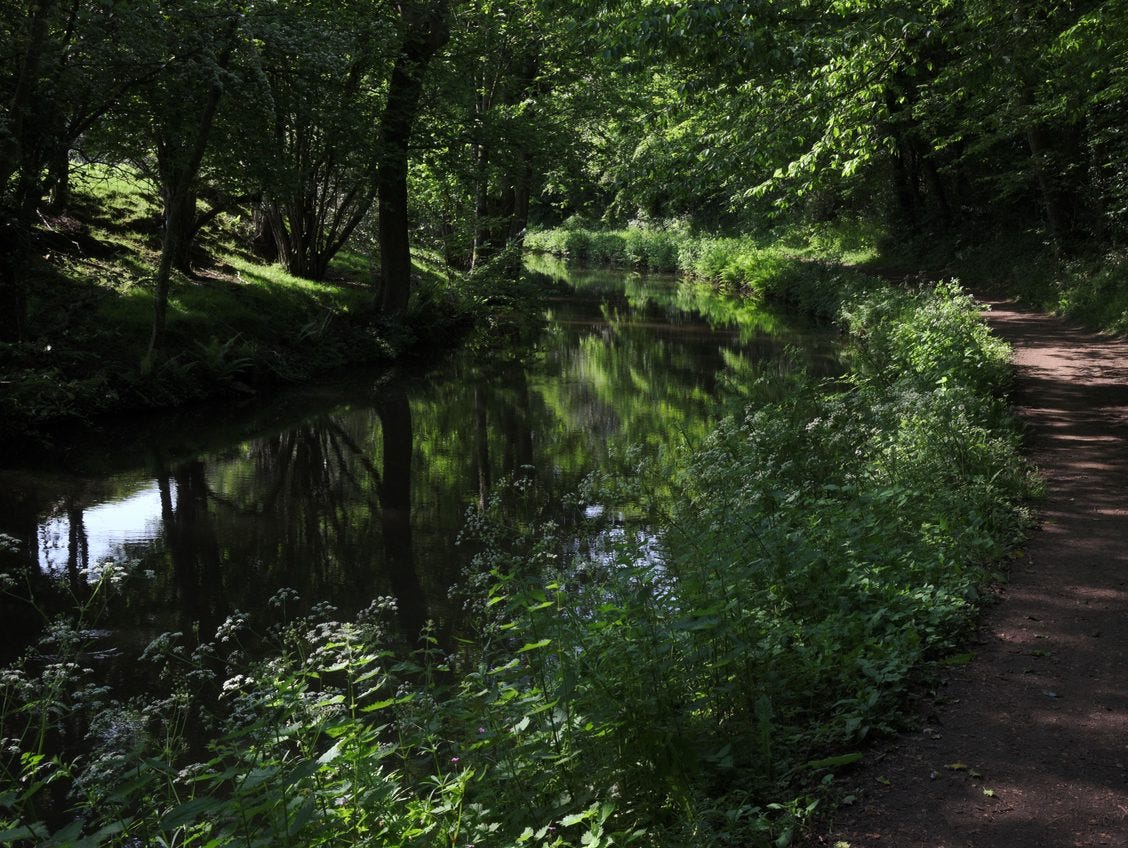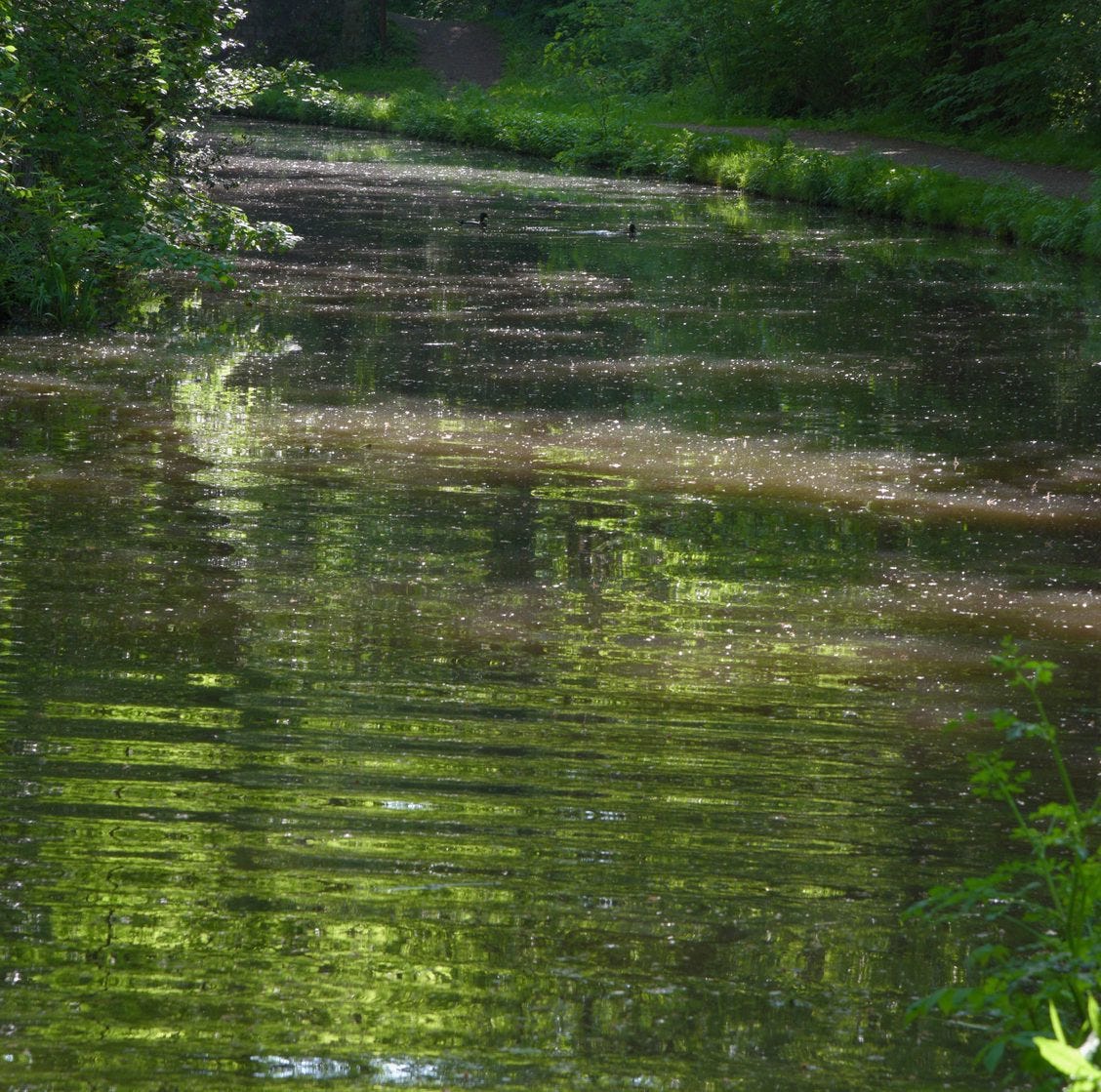Today I walked along the canal in the first summer warmth, the oak trees lining the water now in leaf, each translucent like new skin over a healing wound. I sat beside a winding hole, a place where the tillermen used to use the wind to help turn their loaded narrowboats. As I sat down I heard a splash and saw a ring in the water. A split second later a kingfisher exploded out of it and rose with a silver fish in its beak.
We moved our narrowboat, Masquerade, here in late October, as the leaves began to fall. Bad weather set in which lasted 7 months. The mooring is only a few miles from the sea and surrounded by high hills producing a wet microclimate perfect to dissolve steel boats. A few weeks after we arrived a section of the canal a few miles away was drained and the flow from the locks which fills this part of the canal blocked. The water level dropped and Masquerade was beached in the silt for many weeks. So we’ve gone nowhere in the time since we got here. It’s allowed us to get to know the neighbours.
There is a small group of people who live on their boats full time, cruising from one temporary mooring to the next, working online, nearby or not at all. A few are recent retirees enjoying life on the water before old age sets in. Others are young couples who find living on the canal more cost effective than renting flats or houses in towns. Both groups, like me, are here for the romanticism of an off-grid life, independence, and the beauty of living in a national park. There are other people, however, who seem to have been forced here, or at least got stuck. In the past weeks I’ve been watching a little blue boat which seems to be permanently stranded a few metres beyond the canal bridge just north of the wharf. The boat is an old cruiser about 25 feet long. There are no curtains in the windows and I can see a makeshift bed with sleeping bag, a camping stove and tins of food. A little handwritten sign in the back window reads “Boat awaiting repair”. A few days ago I met the owner as I turned Masquerade in the winding hole nearby. She told me she was waiting for a new battery to start the engine. I’m guessing the blue boat is her only shelter, a form of floating homelessness. Another vessel I see all the time is a battered narrowboat, its roof piled with broken branches collected from the towpath, its stern and bow crammed with tat - fuel cans and paint jars, dog bowls, cracked trays, rusted spanners, plastic flowers, oily gloves, boxes of face masks. The owner socialises by lighting a fire on the towpath in the evenings, talking to passing dog walkers. I’ve had one short conversation with him and I told him about my new project, a book about living simply, working by hand. He told me it was elitist bullshit. I guess he’s busy surviving. I don’t think he realises that I am too.
Boats need constant repair in this wet, wintry canal system. Masquerade is 30 years old and the to-do list is getting longer - bathroom sink cracked, cold tap not working, rusting floor in the bow, leaking window, failed propeller seal, broken fridge, galley lights burned out. I’m not a natural at these repair jobs, and after years of juggling my time desperately to keep a creative practice going I still find excuses not to keep up with the schedule, especially now I know that the previous owner of the boat was a bodger extraordinaire (lights housed in cornflakes boxes, engine water cap sealed with a rubber glove). Last week I watched a neighbour, the owner of a gleaming and immaculate narrowboat called Slowgoing, spend a whole week removing windows, painting the metal behind and putting them back, a loving preventative maintenance routine which borders on infatuation. In response I fixed a leaking pipe connected to our toilet, a filthy job which took me 2 days. I have not sworn so much in decades and I’m now taking a break from boat maintenance, perhaps for the summer.
I’ve started to think that creative practice is a form of repair. The craft certainly is. Almost every mark I make, or word I write, requires correction. The sentences I’m producing now grow across the white space of the page, then shrink or vanish to be replaced, re-shaped, honed and made better. My drawings are nine parts erasure. The work of a book begins half-formed and rickety, loosely bolted together. Each draft is a repair. This leads back to what’s behind the craft, the source, the space which sparks the work, the feel of the thing needing to be expressed. There’s a brokenness there too. Ted Hughes said that all great poems come from a wound. I don’t know what he meant by great, but I think a worthwhile piece of art has to move us and what moves us most is the brokenness of things. There’s so much that’s broken, so little time for reparation. This is built into the system. It’s why so many artists find it hard to survive, because survival is a constant act of reparation.
While I was walking the towpath this evening I passed a couple out with their spaniels. One of the dogs looked up at me and grinned, the way spaniels do. It was soaked to the skin and delighted by that. The other faced away, its head being stroked by its owner. This one had paralysed back legs, strapped up onto a little trolley with two wheels either side. When the dog turned round it gave me the same grin as its sibling, oblivious seemingly to its circumstances and perfectly happy with the improvised repair made to its broken body. That dog has made my day. There’s so much joy in just being here.
I passed the little blue boat on the way back. It had moved fifty metres further along the canal. At first I thought the owner wasn’t onboard, but then I heard music coming from the cabin and saw a pair of shiny booted feet through the window, swinging to the beat. Perhaps her boat has been repaired and she has a summer of cruising this amazing waterway ahead of her, in the shade beneath the oak trees, where the kingfishers dive.






Lovely, James, thank you. This:
'...what’s behind the craft, the source, the space which sparks the work, the feel of the thing needing to be expressed. There’s a brokenness there too. Ted Hughes said that all great poems come from a wound. I don’t know what he meant by great, but I think a worthwhile piece of art has to move us and what moves us most is the brokenness of things. There’s so much that’s broken, so little time for reparation. This is built into the system. It’s why so many artists find it hard to survive, because survival is a constant act of reparation.'
I found you on Notes and I’m so glad! I live in the north woods in the upper reaches of the U.S, where there’s no such thing as narrow boats, but I’ve binge-watched so many shows about them this feels very familiar.
I love your writing style and can’t wait to follow along.